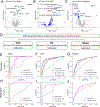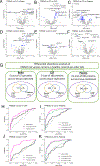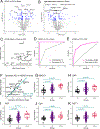Proteomics of brain, CSF, and plasma identifies molecular signatures for distinguishing sporadic and genetic Alzheimer's disease
- PMID: 37406134
- PMCID: PMC10803068
- DOI: 10.1126/scitranslmed.abq5923
Proteomics of brain, CSF, and plasma identifies molecular signatures for distinguishing sporadic and genetic Alzheimer's disease
Abstract
Proteomic studies for Alzheimer's disease (AD) are instrumental in identifying AD pathways but often focus on single tissues and sporadic AD cases. Here, we present a proteomic study analyzing 1305 proteins in brain tissue, cerebrospinal fluid (CSF), and plasma from patients with sporadic AD, TREM2 risk variant carriers, patients with autosomal dominant AD (ADAD), and healthy individuals. We identified 8 brain, 40 CSF, and 9 plasma proteins that were altered in individuals with sporadic AD, and we replicated these findings in several external datasets. We identified a proteomic signature that differentiated TREM2 variant carriers from both individuals with sporadic AD and healthy individuals. The proteins associated with sporadic AD were also altered in patients with ADAD, but with a greater effect size. Brain-derived proteins associated with ADAD were also replicated in additional CSF samples. Enrichment analyses highlighted several pathways, including those implicated in AD (calcineurin and Apo E), Parkinson's disease (α-synuclein and LRRK2), and innate immune responses (SHC1, ERK-1, and SPP1). Our findings suggest that combined proteomics across brain tissue, CSF, and plasma can be used to identify markers for sporadic and genetically defined AD.
Conflict of interest statement
Dr. Fagan has received research funding from the National Institute on Aging of the National Institutes of Health, Biogen, Centene, Fujirebio and Roche Diagnostics. She is a member of the scientific advisory boards for Roche Diagnostics and Genentech and also consults for Diadem, DiamiR and Siemens Healthcare Diagnostics Inc. There are no conflicts. Dr. Seyfried is co-founder of Emtherapro Corp. There are no conflicts.
Figures





References
-
- McKhann G, Drachman D, Folstein M, Katzman R, Price D, Stadlan EM, Clinical diagnosis of Alzheimer’s disease: report of the NINCDS-ADRDA Work Group under the auspices of Department of Health and Human Services Task Force on Alzheimer’s Disease. Neurology 34, 939–944 (1984); published online EpubJul (10.1212/wnl.34.7.939). - DOI - PubMed
-
- Bateman RJ, Xiong C, Benzinger TL, Fagan AM, Goate A, Fox NC, Marcus DS, Cairns NJ, Xie X, Blazey TM, Holtzman DM, Santacruz A, Buckles V, Oliver A, Moulder K, Aisen PS, Ghetti B, Klunk WE, McDade E, Martins RN, Masters CL, Mayeux R, Ringman JM, Rossor MN, Schofield PR, Sperling RA, Salloway S, Morris JC, N. Dominantly Inherited Alzheimer, Clinical and biomarker changes in dominantly inherited Alzheimer’s disease. N Engl J Med 367, 795–804 (2012); published online EpubAug 30 (10.1056/NEJMoa1202753). - DOI - PMC - PubMed
-
- Guerreiro R, Wojtas A, Bras J, Carrasquillo M, Rogaeva E, Majounie E, Cruchaga C, Sassi C, Kauwe JS, Younkin S, Hazrati L, Collinge J, Pocock J, Lashley T, Williams J, Lambert JC, Amouyel P, Goate A, Rademakers R, Morgan K, Powell J, St George-Hyslop P, Singleton A, Hardy J, Alzheimer Genetic Analysis G, TREM2 variants in Alzheimer’s disease. N Engl J Med 368, 117–127 (2013); published online EpubJan 10 (10.1056/NEJMoa1211851). - DOI - PMC - PubMed
Publication types
MeSH terms
Substances
Grants and funding
LinkOut - more resources
Full Text Sources
Medical
Research Materials
Miscellaneous

